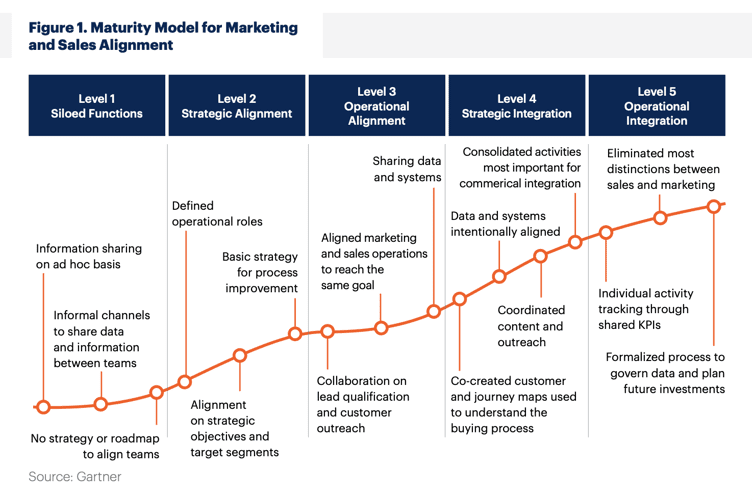The pressure is continuing to build on marketing teams to be even more efficient, find unicorn resources to cover increasingly diverse skill sets, and demonstrate value (i.e. influence on revenue) to the senior team.
Despite that, we have been having some pretty upbeat discussions; people are rising to the challenge and there has been a reassuring level of calm from both in-house marketers and agency leaders who are confident that it’s not time to throw in the towel and start an artisanal pickle business from the garage just yet.
60% of marketers lacking technical skills to operate tech in the toolkit
 According to our friends over at Gartner, a high proportion of marketing leaders are lacking key technical skills and support in their teams.
According to our friends over at Gartner, a high proportion of marketing leaders are lacking key technical skills and support in their teams.
The two big issues that struck us relate to integration and operation; the basics of putting a toolkit together!
1. Integration
Do the tools all work together and can we get data flowing between them to support our objectives?
2. Operation
Do our people understand how to fully utilise the tools we have to do their jobs?
Lack of knowledge in marketing teams can cause a few key issues for you and your team.
- Reliance on other teams / external suppliers to progress initiatives (see the first point in the image)
- Inefficiency in team operation due to basic, repetitive work being done by people
- Context-switching slowing down performance – this is a hidden killer of productivity in marketing
- Wasting money through duplication or even surplus licensing and contracts
Luckily, it’s quite easy to identify and address these issues in your team.
Practically speaking, you can probably save some money right off the bat by reducing duplication or overlap.
Planning for the next 12 months, you can use the output to create a new, leaner tech stack to support your objectives and then use that as a way to build a much more focused education program for your team.
When we’re auditing a tech stack we look at five key areas:
- Purpose – what’s it for and is it the best fit
- Usage – is it getting used by everyone and used as intended (see #1)
- Duplication / overlap – functional overlap in your tools
- Budget – who pays for it and, if you do, when was the agreement last reviewed
- Quick wins – what could you do in the next 30 days
Marketing-Sales alignment – have you done a maturity health check recently?
Another topic that’s been coming up a lot in conversation recently is our old pal – alignment between sales and marketing.
Everyone is
aiming for 3+ territory, however, most people we’ve been speaking to recently are currently at L1 or L2.
The most common problems that arise from the first two stages all relate to lead flow:
- Marketing leads are not progressed/prioritised by sales
- We’re speaking to the right people but no one is buying
- Leads are getting stuck in the pipeline, but we don’t know why
These are important challenges because they directly impact your ability to grow your business.
So why are we telling you to do a
maturity check now? Well to me, a core component you need to become more mature is a defined, actionable customer journey map.
If you don’t understand the full journey your buying is undertaking, you’ll never be able to fix your lead flow issues.
This goes beyond “tick x amount of boxes, now they’re an SQL”, it means building a practical understanding of buyer behaviour (spoiler alert – they don’t really want to talk to you in the early stages – when you can actually influence a decision) and building a journey that you can measure into your marketing and sales functions.
Now that is not anywhere near as complicated as it might sound; simply starting with what you know, and what you have, will set you on the right path.
This exercise will also help you address some of those technical skill challenges we mentioned at the start.
Is Account Based Marketing (ABM) worth the effort?
Finally, we get asked this question quite a bit, so we wrote a short article about it to answer that question (you can read the full article here).
The reason we think ABM is worth considering right now is that it helps focus your efforts on high-value prospects, creates natural alignment with sales and makes your activity measurable against revenue immediately.
It’s a compelling item to include in your plans.
Alternatively, if you’re already running with ABM, there are always ways to improve efficiency and optimise your process based on the two areas I’ve just been talking about.
Account Based Marketing is certainly not right for everyone, however, we have found through our client relationships that for large tech businesses it can make a huge difference both in returns and in marketing-sales operations.
You need a few prerequisites in place to make sure it’s worth the effort; including a good idea of who your top 1% ideal clients are and confidence that the lifetime value of that client will justify the extra investment.
It’s pretty easy to set up a focused pilot program to test the approach. Alternatively, if you’re already running with ABM there are always ways to improve efficiency and optimise your process based on the two areas we’ve just been talking about.
Until next time…
Thanks for reading this far!
We hope you found this interesting. We’d love to know what you would like to hear more of (or less of) and we’re always happy to chat if you would like to discuss anything.

